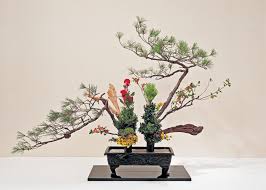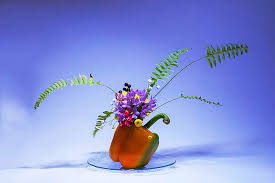Ikebana, the traditional Japanese art of flower arrangement, has captivated hearts and minds for centuries with its exquisite beauty and profound symbolism. Rooted in Zen Buddhism, Ikebana goes beyond the mere arrangement of flowers; it is an art form that seeks to harmonize the natural beauty of the elements and express the balance between nature and humanity. As practitioners carefully select and arrange flowers, branches, and leaves, they create captivating compositions that evoke emotions and inspire contemplation.
Originating in the 7th century, Ikebana has evolved over the centuries, influenced by the changing cultural, religious, and social aspects of Japan. Its name, which means “making flowers alive,” reflects the essence of this art as it brings life to the floral elements and establishes a deep connection between the arranger and nature.
Central to Ikebana is the idea of asymmetry and negative space. Unlike traditional Western flower arrangements, which often aim for fullness and symmetry, Ikebana focuses on simplicity, emptiness, and the beauty of each individual element. The space surrounding the flowers is as essential as the flowers themselves, creating a sense of harmony and balance that embodies the Japanese aesthetic principle of “Ma” – the appreciation of the space between objects.
Another vital aspect of Ikebana is its profound symbolism. Each flower, stem, and branch carries meaning, and the arrangement often tells a story or expresses emotions through its careful placement. The three primary elements in Ikebana are “Shin” (symbolizing heaven), “Soe” (representing human beings), and “Hikae” (referring to earth). These elements, when combined thoughtfully, establish a spiritual connection between the arranger, the viewer, and nature.
Ikebana is more than just a decorative art; it is a meditative and contemplative practice. As artists engage with the materials and design their arrangements, they experience a state of mindfulness and focus. The process of creating Ikebana encourages practitioners to be fully present, embracing the beauty of impermanence and accepting the passage of time.
Over the years, Ikebana has spread its influence worldwide, captivating individuals from diverse cultures. Enthusiasts of this traditional art form gather in schools and workshops to learn the techniques, traditions, and philosophies behind Ikebana. These schools, or “ryuha,” each have their unique approach to the art, ensuring that Ikebana continues to evolve while preserving its traditional essence.
Beyond its spiritual and artistic merits, Ikebana has found a place in modern settings, gracing homes, hotels, and public spaces with its elegance. The simplicity and serenity of Ikebana arrangements have made them an attractive addition to contemporary interior design, providing a touch of natural grace that complements any space.
Ikebana’s enduring appeal lies in its ability to embody the delicate dance between humanity and nature. With each arrangement, Ikebana artists celebrate the ephemeral beauty of flowers, the simplicity of design, and the connection between the elements, inviting us all to pause, reflect, and find solace in the natural world.
However, Ikebana stands as a testament to the profound artistic and spiritual heritage of Japan. As we immerse ourselves in this ancient tradition, we discover a timeless art form that transcends cultural boundaries, inviting us to experience the beauty and interconnectedness of the natural world. Embracing Ikebana’s philosophy can open our hearts and minds to a deeper understanding of nature’s grace and enrich our lives with a sense of tranquility and harmony that endures through the changing seasons of life.
Read Also: The Different Types of Housing for Fishes
History and Significance of Ikebana Flowers

Ikebana, with its rich history and profound significance, has become a cherished art form that embodies the spirit and cultural heritage of Japan. Dating back to the 7th century, the roots of Ikebana can be traced to the introduction of Buddhism from China, where offerings of flowers were made at altars. As the practice of Buddhism spread throughout Japan, so did the art of flower arrangement, eventually evolving into the unique art form we know today as Ikebana.
During the Muromachi period (1336-1573), Ikebana began to flourish under the influence of the powerful Ashikaga shogunate. It was during this time that the first schools or “ryuha” of Ikebana were established. The oldest and most influential of these schools is the Ikenobo school, founded by Ikenobo Senkei.
Other prominent schools include the Sogetsu school, founded by Sofu Teshigahara in the 20th century, and the Ohara school, founded by Unshin Ohara in the 19th century. Each school has its unique style and teachings, ensuring the preservation and evolution of Ikebana through generations.
In the early days, Ikebana was primarily practiced by Buddhist priests and aristocrats, serving as a spiritual offering and a way to communicate with the divine. As time passed, Ikebana gradually became more accessible to the general population, and its significance expanded beyond religious contexts. Today, people from various walks of life practice Ikebana as a form of personal expression, as a way to connect with nature, and as a means of finding inner peace and tranquility.
One of the distinguishing features of Ikebana is its profound symbolism. Every element in an arrangement carries meaning, and each arrangement tells a story or conveys an emotion. Flowers, stems, and branches are carefully chosen for their shapes, colors, and textures, and their placement within the arrangement is deliberate. For example, a single branch may represent the beauty of solitude, while a combination of different flowers might symbolize the harmony and diversity of the natural world. Ikebana arrangements often draw inspiration from nature, capturing the essence of the seasons and celebrating the fleeting beauty of flowers.
The philosophy behind Ikebana extends beyond aesthetics and symbolism; it reflects a deep respect for nature and an understanding of the interconnectedness of all things. Ikebana practitioners observe the principles of balance, harmony, and simplicity as they create their arrangements. The use of negative space and asymmetry, known as “Ma,” is integral to Ikebana, emphasizing the importance of the space between the elements as much as the elements themselves. This appreciation for emptiness and balance mirrors the broader Japanese aesthetic sensibility, influencing various art forms, including architecture, calligraphy, and tea ceremony.
In addition to its aesthetic and philosophical significance, Ikebana holds a special place in Japanese culture and society. Ikebana arrangements often grace ceremonial occasions, such as weddings, funerals, and traditional tea ceremonies. The beauty and grace of Ikebana are seen as a way to honor the importance of the moment and create a serene atmosphere. Furthermore, Ikebana has become a part of daily life in Japan, with many households incorporating floral arrangements as an integral part of their interior design.
However, Ikebana’s history and significance are deeply intertwined with the cultural fabric of Japan. From its humble origins as a Buddhist ritual offering, it has grown into a cherished art form celebrated for its symbolism, aesthetics, and meditative qualities.
Read Also: How many plots of land do I need to start fish farming?
Uses of Ikebana Flowers

Ikebana, as a versatile art form, finds various uses and applications in different contexts. Here are some of the common uses of Ikebana:
Decorative Art: Ikebana arrangements are widely used as decorative elements in homes, offices, hotels, and public spaces. The unique beauty and elegance of Ikebana compositions add a touch of natural grace to any environment. The arrangements are carefully designed to complement the surrounding space, creating a harmonious and aesthetically pleasing atmosphere.
Ceremonial Occasions: Ikebana holds a significant place in various ceremonial occasions in Japanese culture. For example, in weddings, Ikebana arrangements symbolize the union of two individuals and are often displayed on the altar or as table centerpieces. Similarly, Ikebana is used in funerals to pay respects to the deceased, offering a serene and contemplative presence.
Cultural Festivals: Ikebana plays a prominent role in traditional cultural festivals and events in Japan. During festivals like Hanami (cherry blossom viewing) or Hana Matsuri (Buddha’s birthday), Ikebana arrangements are showcased to celebrate the beauty of nature and the changing seasons. These displays often attract large audiences and create a visually stunning backdrop for the festivities.
Meditation and Mindfulness: Ikebana is known for its meditative qualities and is practiced by individuals seeking a sense of tranquility and mindfulness. Engaging in the process of arranging flowers requires focus, attention to detail, and a deep connection with nature. Many people find Ikebana to be a therapeutic activity that helps reduce stress, promote relaxation, and enhance mindfulness.
Personal Expression and Creativity: Ikebana offers individuals a platform for personal expression and creativity. Practitioners can explore their artistic inclinations and experiment with different combinations of flowers, branches, and containers. Through Ikebana, individuals can convey their emotions, tell stories, or create arrangements that reflect their unique perspectives and aesthetic sensibilities.
Education and Learning: Ikebana is taught in various schools and workshops worldwide, offering people the opportunity to learn and master this ancient art form. Ikebana classes provide a structured environment where students can develop their skills, learn about the principles and techniques of Ikebana, and deepen their understanding of Japanese culture and aesthetics. Ikebana education promotes discipline, creativity, and a greater appreciation for nature.
Cultural Exchange: Ikebana serves as a medium for cultural exchange and understanding between different societies. As the art form gained international recognition, practitioners from diverse backgrounds embraced Ikebana and integrated its principles into their own artistic practices. Ikebana exhibitions, demonstrations, and workshops contribute to fostering cross-cultural dialogue and appreciation for the beauty of different floral traditions.
Whether used for decoration, meditation, cultural celebrations, or personal expression, Ikebana continues to enrich lives with its timeless beauty and significance. Its versatility and ability to transcend cultural boundaries make it a cherished art form that resonates with people around the world.
Read Also: DIY: How to Build a Backyard Pool Within Minutes
